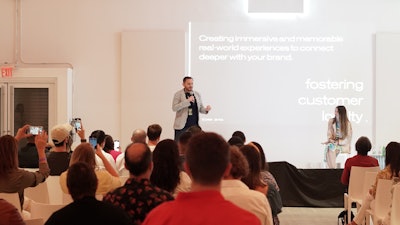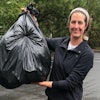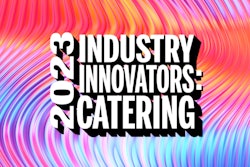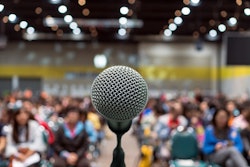
MIAMI—Hospitality leaders and F&B innovators recently gathered at Lengua Conference 2023 in Miami to discuss what’s next in food and beverage marketing and branding.
The two-day event kicked off its second year at Miami’s The Sacred Space from May 30 to June 1, backed by sponsors American Express, Resy, Sanpellegrino, and Stella Artois. The food marketing event aims to unite these groups and propel the industry forward through discussions on restaurant and brand development; product innovation; global disruption; and experiential marketing tactics, tips, and trends.
This year’s Lengua doubled in size and breadth, welcoming 200 attendees (up from the single-day event’s 80-person attendance last year). Headline keynotes, interactive panels, and post-event networking anchored the gathering. Among this year’s agenda upgrades were product tastings by Miami-grown vendors during breaks, including Vice City Coffee, The Salty, Radiate Kombucha, Caracas Bakery, Craize, and Sommos Chocolates. Sanpellegrino also provided sips throughout the day.
 Event sponsor Sanpellegrino was on hand to provide sips throughout the day.Photo: C&I Studios
Event sponsor Sanpellegrino was on hand to provide sips throughout the day.Photo: C&I Studios
Meanwhile, Stella Artois and Smorgasburg Miami supplied Lengua’s networking happy hour libations and bites. Additionally, Lengua’s 2023 itinerary added four intimate dinners featuring esteemed guest chefs and venues. The nightly sit-downs included inventive suppers by Manu Buffara of Brazil—named Latin America's Best Female Chef 2022 by The World's 50 Best Restaurants—and Christine Lau of New York City, whose restaurant Kimika was a 2022 James Beard Award semifinalist for Best New Restaurant.
“Most events in the U.S. focus on providing culinary experiences to the end consumer, which is great, but few focus on providing knowledge to industry professionals, especially in food marketing,” said Nidal Barake, founder and managing director of Gluttonomy, the agency that produces Lengua. “Lengua 2022 was our first attempt at bringing a thoughtful conference for F&B industry professionals, and the topics were broad. But thanks to the great welcoming and encouraging words from attendees, we made the conference bigger and started focusing on specific topics within food marketing. So, 2023 was all about how to build an F&B brand.”
Chef JJ Johnson’s opening keynote on “Growing a Restaurant Brand Through Community Involvement” centered on the many lessons he learned while opening his rice-based, fast-casual concept FIELDTRIP in Harlem. He touched on the importance of face-to-face communication and education and later shared how his initial go-to-market plan and perspective shifted.
 Among this year’s agenda upgrades were product tastings by Miami-grown vendors during breaks, including Radiate Kombucha.Photo: C&I Studios
Among this year’s agenda upgrades were product tastings by Miami-grown vendors during breaks, including Radiate Kombucha.Photo: C&I Studios
“The way I marketed FIELDTRIP initially was through family and friends,” Johnson said. “The way the brand is marketed now is through social media, PR, and word of mouth. The goal of FIELDTRIP has always been to introduce new people to our food and become a fast-casual staple in the Harlem and Rockefeller Center markets. That takes time with growth and awareness, where initially I thought that would happen overnight.”
Johnson’s candor and hard-fought lessons were a recurring theme at Lengua. Fellow industry leaders and marketing professionals echoed trial-and-error insights while also discussing what’s next in experiential marketing, branding, and innovation.
Below are some key takeaways that event profs should note from the talks at Lengua Conference 2023...
What to always consider when planning an experiential marketing campaign or event
Filippo Mazzaia, head of market development at Nestlé Premium Waters, S.Pellegrino:
- Understand your consumer through market research, customer surveys, direct contact or interaction, social media, and email retargeting.
- Have a clear, meaningful, and authentic message because you have five seconds to connect with your audience. Share your story and values and what might be relevant to your audience.
- Create memorable activities that win the heart and minds of your audience. Activities should be sensorial and emotional and remembered tomorrow, in one week, and one year from now. The one thing experiential marketing should be is translated into the everyday experience.
- Leverage technology to prolong the event experience. Use it but don’t abuse it.
- Set goals and measure them. Evaluate each campaign for constant improvements directly (attendance, interactions, engagements, reposts, tags, and positive comments) and indirectly (brand sentiment, households acquired, and consumption levels).
Top trends in experiential marketing right now
Galia Sandler, general manager at BVRG:
- Sensory marketing and multisensory experiences: Incorporating all the senses helps the memory repeat itself and resonates on an emotional level—this is how the event stays with your consumer.
- Sustainability and social impact: Create more experiences that resonate with socially conscious consumers to foster a positive brand image. For example, Terratela is transforming food loss into fabrics. It connects two industries that need social solutions.
- Phygital experiences: The blend of physical and digital experiences, and it doesn’t have to be complicated. You can be at an event and simply click somewhere to buy something you see with a QR code. Think about the marketing funnel from awareness to conversion.
- Gamification: For example, gamers get badges or native tokens. Badges are social currency, and more brands are doing this. An escalating points system unlocks specialty rewards, perks, and experiences.
- Alternative nightlife: Gen Z has shown a disinterest in traditional nightlife, due in part to rising living costs. There are also a number of people abstaining from alcohol (20% of Gen Z) and “rave fatigue.” Consumers are interested in a different type of club culture to find that balance between hedonistic and healthy.
- AI and personalization: As AI becomes more sophisticated, it will enable hyperpersonalized experiences. This organization of data can help predict what consumers want and tailor experiential experiences to make consumers feel valued and understood.
- Experiences as a service: How can a brand offer unique experiences to loyal customers and subscribers? An example is how Dante’s in New York can print a photo of you onto your espresso martini.
 This year’s Lengua doubled in size and breadth, welcoming 200 attendees (up from the single-day event’s 80-person attendance last year).Photo: C&I Studios
This year’s Lengua doubled in size and breadth, welcoming 200 attendees (up from the single-day event’s 80-person attendance last year).Photo: C&I Studios
How to manage and justify budgets for experiential marketing, public relations, and social media
Alejandro Diaz, founder of Miami Slice, La Latina:
“If you have the budget, use it. It’s like a rocket booster behind you. We were fortunate to get our pizza in the right hands—influencers, industry, food writers, etc. Some of these people we never called. There was a big effort in planning how we were going to do this… [and] the look is important. Luckily, we have somebody on our team in-house who is naturally good at picking out things that are shareable. The branding elements were thought out so that they would be recognizable when shared, so that when the hype happens, you’re ready to take advantage. Having someone with us documenting our process made it real and it resonated. That UGC is what gave us exponential growth.”
Filippo Mazzaia, head of market development at Nestlé Premium Waters, S.Pellegrino:
“One of the most difficult things to measure is ROI for experiential marketing, and when there are budget cuts, the least clear-producing ROI segment is the first thing to go—and it is usually marketing. In our company, we tie experiential with market development. When you cannot measure large scale, start with small scale. [With our Miami events], we kept measuring directly (like the number of samples we distributed) and indirectly (like how the market evolved from when we started the program). We asked, who is buying? What are the sales in major retailers? When we started in Miami, the household use was less than 10%. Then we hit 30%. Be measure obsessed, and be strong with your numbers [to help justify experiential budgets]."
Galia Sandler, general manager at BVRG:
“Try to always take a 360 approach, and ask: How can the engagement turn into a conversion? How can we tie this activation with retailers nearby?”



















